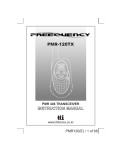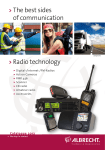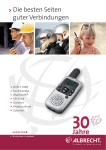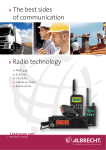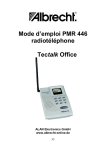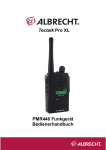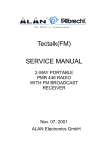Download Albrecht Tec talk smart User manual
Transcript
Tectalk smart User Manual Speaker Microphone/ 1 Charger Jack PTT Button 2 Down Button 3 Mode/ Lock Button 4 Microphone 5 6 Antenna 7 LCD Display 8 Up Button Power/ 9 Scan Button 10 Speaker Thank you for purchasing this Albrecht PMR 446 radio. All our products are built to offer excellent value by combining advanced features, great design and manufacturing quality. To ensure you are familiar with the operation and features of your radio and in order to obtain the best performance, please read this manual carefully before operation. 1. Contents 1. Contents 2. CAUTION 3. LCD Display 4. Equipment and Accessories Supplied 5. Powering the transceiver 6. Installing the batteries 7. Charge Information 8. Control Buttons (1) Power on-off button (2) Push-To-Talk (PTT) button (3) Up button (4) Down button 9. Operating Modes and Features (1) PMR Operation (2) Channel Selection (3) CTCSS Mode Selection (4) VOX Mode Selection (5) Roger Beep Tone (6) Button Beep (Keytone) (7) Call Ringer (8) Keypad Lock (9) Channel Scan Operation (10) Battery Alert (11) Backlighting 10. Note for Good Communication 11. Warning 12. Troubleshooting 13. Technical Specifications 14. Main Channel Frequency Table 15. CTCSS Tone Subcode Table 16. CE Declaration 17. Safety Requirement 3 3 5 6 6 6 6 7 7 7 7 7 8 8 8 8 8 8 9 9 10 10 10 10 10 11 11 12 12 12 12 13 13 2. CAUTION NEVER ATTEMPT TO CHARGE ALKALINE OR DRYCELL BATTERIES, AS BATTERIES MAY BURST CAUSING PERSONAL INJURY AND DAMAGE TO THE PRODUCT. WHEN RECHARGING NICKEL METAL HYDRIDE (Ni-MH) BATTERIES WITH THE SUPPLIED CHARGER AND WALL ADAPTOR, USE ONLY APPROVED RECHARGEABLE BATTERIES. USE OF CHARGERS WITH OTHER BRANDS OF BATTERIES IS NOT RECOMMENDED, AS BATTERY CHARGING TIMES WILL VARY WITH DIFFERENT BRANDS. AVOID PLACING THE TECTALK SMART TRANSCEIVER FOR PROLONGED PERIODS OF TIME IN DIRECT SUNLIGHT OR TEMPERATURES BELOW -20ºC OR ABOVE 60ºC. KEEP THE ANTENNA AT 1 INCH (2.5cm) AWAY FROM YOUR HEAD AND BODY. DO NOT USE YOUR TECTALK SMART RADIO TRANSCEIVER WITH A DAMAGED ANTENNA. 4 3. LCD Display 1 2 3 4 7 5 8 1. Transmit Indicator 2. Busy Indicator (Upon receiving a transmission) 3. Roger Beep Tone Indicator 4. Lock Indicator 5. CTCSS Subcode Indicator 6. Low Battery Level Indicator 7. Channel Number Display 8. Voice Activated Tansmission indicator 9. Channel Scan 6 9 4. Equipment and Accessories Supplied Albrecht Tectalk Smart (double pack) 1) Radio (2) 2) Instruction Manual (1) Optional Accessories : 1) AC Wall Charger 2) Rechargeable Batteries Albrecht Tectalk Smart (complete set package) 1) Radio (2) 2) Instruction Manual (1) 3) AC Wall Charger 4) Rechargeable Batteries Special Deliveries may contain 2 sets of MicHeadphone sets (not designed for use on motor-bikes) 5. Powering the transceiver Your Tectalk Smart PMR 446 radio operates on three AAA batteries. Fresh Alkaline batteries will provide slightly longer operation time than rechargeable batteries. When using rechargeable batteries, battery charging time is typically 12-15 hours. (You are recommended to charge two radios at the same time.) 5 6. Installing the batteries Battery installation is made more convenient when the belt clip is either rotated left or right to the horizontal position, or is removed. simply rotate the clip in either direction to the horizontal position. Be careful not to use excessive force. To remove the clip, press down on the spring release tab and pull the clip straight out from the radio body. CLIP SPRING RELEASE TAB COVER ARROW BELT CLIP POSITIVE TERMINALS BATTERY COVER 1. Using thumb, press down on battery cover at arrow and slide cover down. 2. Then lift cover at bottom to open. Remove cover. 3. Insert three AAA batteries (positive (+) end toward the top begining at left side and alternating positive terminals as shown). 7. Charge Information (For Set Package version) ADAPTOR POWER PLUG INPUT : 230VAC OUTPUT : 6VDC NOTE: Only ALAN / Albrecht recommended rechargeable batteries shall be recharged in the radio transceiver. 6 8. Control Buttons (1) Power on-off Button Press and hold the POWER on/off button for at least 2 seconds.You will hear a confirming melody to indicate the unit is on. To turn the unit off, press and hold the button for at least 2 seconds. (2) Push-To-Talk (PTT) Button Pressing and holding this button will allow you to speak to any transceiver that is set to the same channel and privacy code setting as yours. Hold the transceiver approximately 2 to 3 inches from your mouth as you speak into the built in microphone. After you have finished speaking, release the PTT Button to allow reception of incoming signals. Whenever the button is pressed, the transmit icon ( ) will appear. When receiving an incoming signal, the BUSY ( ) icon will appear. The PTT button can also be used as a two-way call ringer. Pressing the button twice quickly will call another party on the same channel. (3) Up Button In the standby mode, pressing this button will increase the listening volume. The current volume is indicated (1-7). When in function edit mode this button will be used to adjust the unit's settings. (4) Down Button In the standby mode, pressing this button will decrease the listening volume. When in function edit mode this button will be used to adjust the unit's settings. 9. Operating Modes and Features (1) PMR Operation - Press and hold the POWER On/Off button for 2 seconds to turn on power. - Press the MODE button so the channel number flashes. - Select the desired channel with the Up and Down Buttons. 7 The BUSY icon ( ) appears to indicate an incoming call. - Press and hold the PTT button to transmit, then speak into the microphone clearly and slowly. The transmit icon ( ) appears on the display while the button is pressed. - Release PTT button to receive. - Communication can only be accomplished when the channel and CTCSS tone frequency of at least two parties are the same . - The CTCSS subcode (01-38) will be displayed on the LCD panel if the CTCSS tone frequency function is enabled (not oF). (2) Channel Selection - From standby mode, press the MODE button once; the channel number flashes. - Press the Up or down button briefly to move to the desired channel number. - Press the PTT button momentarily to confirm selection. (3) CTCSS Mode (Sub-Channel) Selection - From standby mode,press the MODE Button twice; a flashing oF or sub-channel number is displayed. - Press the Up or Down button to select the desired sub-channel for use (01-38). - Press the PTT button to confirm selection. - The CTCSS mode can be turned off by selecting oF as the setting. NOTE : To communicate with other PMR units, they must be switched to the same channel and CTCSS subcode. To communicate with other PMR units that do not have subcodes, switch your unit to the same channel with the subcode set to oF. The CTCSS subcodes do not prevent others from hearing you transmisstion.This will only allow you to ignore all traffic on a given channel not using the same subcode. (4) VOX Mode Selection When your voice or signal is detected using the internal microphone/headset (purchased separately), the radio transmits automatically without the need to press the PTT button. 8 To enable the VOX operation: - From standby mode, press the MODE button 3 times unitil the blinking VOX icon ( ) appears with on or oF. - Press the Up or Down button to select the VOX on or oF as desired. - Press the PTT button momentarily confirm selection. - When enabled, the VOX icon ( ) appears. (5) Roger Beep Tone The Roger Beep is a tone which is automatically transmittied whenever the PTT button is released. To enable and disable the Roger Beep tone: - From standby mode, press the MODE Button 4 times unitil the flashing Roger Beep icon ( ) appears with on or oF. - Press the Up or Down Button to select the tone on or off as desired. - Press the PTT button momentarily to confirm selection. - When enabled, the Roger beep icon ( ) appears. (6) Button Beep (keytone) This feature allows the transceiver to sound a confirmation tone whenever the following keys are pressed: Power On/Off/ Scan Button, Up/Down Buttonsand MODE Button. This feature is always on. (7) Call Ringer The transceiver provides a transmit call ring melody to alert other users of an incoming call. From standby mode, pressing the PTT button twice in quick succession will transmit the call ringer melody. (8) Keypad Lock The lock function is to avoid the accidental changes of radio settings. The POWER On/Off, PTT and Volume Up/Down button will supercede the lock function. To set the keypad lock operation : - From standby mode, press and hold the MODE button for 2 seconds or until the lock icon ( ) appears on the display. - To disable the lock operation, press and hold the MODE button for at least 2 seconds ; the lock icon ( ) will disappear. 9 (9) Channel Scan Operation This feature allows you to monitor all channels automatically for valid signals. While scanning, you can transmit and receive. When a signal is received, the scan is interrupted and will return to scan mode approximately 5 seconds after the interruption. Note: while the SCAN mode is active, the MODE button is inoperative. In addition, the SCAN mode will reduce the overall battery life since the battery save function is overridden. To enable the channel scan mode: - From standby mode,momentarily press the Power On/Off Button; SCAN will appear on the LCD display. - The radio will automatically display each channel (1-8) in ascending order to find an active main channel. - When the unit doesn't find any signals and you want to transmit, press the PTT Button to return to primary channel operation.The transceiver will automatically resume scanning approximately 15 seconds after the communication is completed. - If there is no activity and you want to leave the scan mode, press the Power On/Off button momentarily and the unit will return to normal operation; the SCAN icon ( ) will disappear from the LCD display. (10) Battery Alert When the low battery icon ( ) blinks steadily on the LCD panel, recharge the unit or install fresh batteries. (11) Backlighting By pressing any buttons, the LCD backlight is turned on. The LCD backlight will be turned off automatically in about 5 seconds after any final button is pressed. 10 10. Notes for Good Communication 1.The PMR446 radio channels are shared on a 'take turns' basis. This means other groups may be talking on any of the channels. A common code of courtesy is to switch to another vacant channel and not to attempt to talk over someone who is already using the channel you first selected. 2.The Tectalk Smart has been designed to maximize performance and improve transmission range in the field. To avoid interference, it is recommended that you do not use the units closer than 5 feet apart. 3.To increase battery life, use the SCAN feature sparingly. This feature will reduce operating time considerably. 11. Warning Remove the batteries from the transceiver if it is not expected to be used for long periods.This will eliminate the possibility of chemicals leaking from the batteries and corroding the transceiver. Avoid exposing the transceiver to water or extremes of temperature. Do not use this device in or near a mining facility, which uses remotely triggered explosives or in areas labeled "Blasting Area". Do not attempt to modify or in any way increase the output of this transceiver. Its output is designed to meet the legal limits. Do not use this device or charge its batteries in potentially explosive atmospheres. Turn your transceiver off wherever posted notices restrict the use of radios or cellular telephones. Facilities such as hospitals may use equipment that is sensitive to RF energy. Turn your transceiver off on board aircraft when requested to do so. Do not place your radio in front of a vehicle's air-bag. If the air-bag deploys, it could propel the transceiver like a projectile causing bodily injury. 11 12. Troubleshooting If you have problems with your Radio, reset your unit by turning it off and removing the batteries. And re-insert the batteries and turn the unit on again. Check the battery power level since in many cases low batteries cause problems such as no transmission, weak receiving signal and low sound. 13. Technical Specifications Operating frequencies 446.00625 to 446.09375 MHz Channel capacity eight channels Channel spacing 12.5KHz Power source 3 X 1.5 V ' AAA' battery or 3 x 1.2 V 14. Main Channel Frequency Table Channel 1 2 3 4 Frequency (MHz) 446.00625 446.01875 446.03125 446.04375 Channel 5 6 7 8 Frequency (MHz) 446.05625 446.06875 446.08125 446.09375 15. CTCSS Tone Subcode Table No. 1 2 3 4 5 6 7 8 9 10 Freq. 67.0 71.9 74.4 77.0 79.7 82.5 85.4 88.5 91.5 94.8 No. 11 12 13 14 15 16 17 18 19 20 Freq. 97.4 100.0 103.5 107.2 110.9 114.8 118.8 123.0 127.3 131.8 No. 21 22 23 24 25 26 27 28 29 30 12 Freq. 136.5 141.3 146.2 151.4 156.7 162.2 167.9 173.8 179.9 186.2 No. 31 32 33 34 35 36 37 38 OF Freq. 192.8 203.5 210.7 218.1 225.7 233.6 241.8 250.3 0 16. CE Declaration The CE marking on the product label demonstrates, that the product complies with the essential requirements of the European R&TTE (Radio and Telecommunication Terminal Equipment) Directive 1999/5/CE. This warning symbol indicates that this equipment operates in non-harmonised frequency bands and / or may be subject to licensing conditions in certain countries. Be sure to check the country list printed on the gift box. If You do not find Your country symbol, You may probably not be allowed to use the radio in Your country. Please find . the original declaration in German manual. As of October 2005, the unit can be used free of charges in: Austria, Denmark, Finland, France, Germany, Great Britain, Greece, Hungary, Ireland, Iceland,Luxemburg, Netherlands, Norway, Portugal, Spain, Sweden, Switzerland. Belgium and Italy still request licence from residents, for travellers use is free. 17. Safety Requirements for Charger For charging the rechargeable batteries, only CE-approved AC adaptor must be used in compliance with the following specifications (never use adaptors with defective parts or cables): * INPUT : AC 230V 50Hz 30mA * OUTPUT : DC 6V 300mA 13














